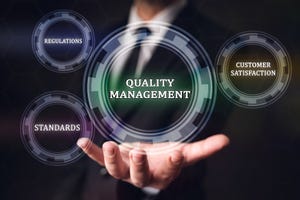FDA Trends for Reusable Medical Device Reprocessing Validations
More complex devices and the rise of hospital-acquired infections are requiring manufacturers to take a second look at validation.
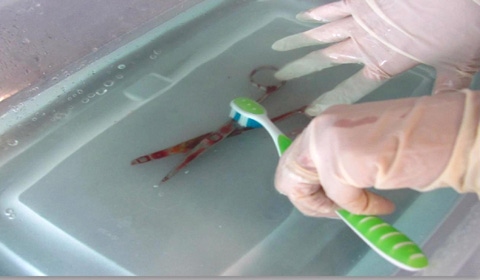
As technology advances, so does the complexity of medical devices. Increased design complexity intensifies the difficulty
|
A medical device going through the cleaning process. |
associated with cleaning, disinfection, and sterilization procedures. Due to these issues and ongoing efforts to control hospital-acquired infections, the reusable medical device industry is facing increased scrutiny to previously accepted validation methods.
FDA is recommending testing procedures that consider worst-case scenarios and closely simulate clinical use of the device. Reprocessing validations have become more robust with many variables to consider. Even with guidance from AAMI documents and a new draft guidance document recently published by FDA, it is difficult for reusable device manufacturers to understand what areas of their test plan currently require greater attention and focus. This article addresses several validation topics to give further guidance and clarity to reusable device manufacturers that are struggling to understand current expectations.
Cleaning validations have historically been performed on devices in new condition since used-condition devices often do not exist for products seeking FDA approval. Because these devices are labeled as reusable, evaluation is critical to understanding how well they can be cleaned during the entire use lifecycle. In the absence of used-condition devices, FDA recommends creating used conditions through repetitive reprocessing. This process allows a device to be tested near the end of its anticipated use life and provides confidence that a validated reprocessing procedure will be appropriate after multiple uses.
Testing Validation
One issue that is catching many manufacturers by surprise is the number of test devices and the number of repetitions that FDA is requesting. The validation should test the number of devices adequate to demonstrate reproducibility and ensure that any device variability in design or manufacturing does not inhibit adequate reprocessing. FDA requests a
minimum of three test devices.1 In recent responses to submissions, FDA has asked for rationale from manufacturers for the number of process repetitions performed on the test devices. Although the agency has refrained from making general recommendations as to what is an acceptable number, it has required some manufacturers to provide additional test repetitions beyond what was considered in their original test plan.
Manufacturers are responsible for choosing an artificial test soil for cleaning validations that simulates the contamination present on the device during and after actual clinical use. AAMI TIR30:2011 lists some test soils that are commonly used. 2 These test soils typically consist of blood, mucin, egg, bacteria, and other ingredients that contribute as sources of protein, carbohydrates, organic carbon, and endotoxin, among other test markers that may be worth evaluating. FDA is asking device manufacturers to carefully consider the worst-case environment for device exposure and then choose an appropriate test soil that most closely simulates those conditions. The test soil should also contain constituents that are applicable to the cleaning markers to be tested. In many cases, the common test soils listed in AAMI TIR30:2011 may not be adequate. Manufacturers should define a test soil that achieves clinical relevancy. Caution should be exercised when adding components to test soils such as bone or tissue that may inhibit many assays involving spectrophotometric analysis. FDA is asking device manufacturers for justification of clinical relevancy as it pertains to test soil contents, proportions of contents, viscosity, and tenacity.
|
A device contaminated with test soil. |
Once a test soil is chosen, contamination procedures should be carefully considered. Validations should incorporate worst-case wet test soil exposure conditions and worst-case dwell time conditions. During testing, the devices should be in contact with the test soil for the same amount of time and under the same conditions as would be expected during clinical use. Device actuations during contamination should also be incorporated as applicable. Although best practice in a clinical setting is not to allow soil to dry onto a device, the reality is that many facilities are not adequately equipped to accommodate immediate processing and devices are not processed until several hours after being contaminated. FDA is requesting that manufacturers account for these situations by allowing the test soil to fully dry onto the test devices before proceeding to the cleaning steps of the validation.
Cleaning Validation
Once the devices are ready to be processed, the next step is to apply minimum cleaning parameters. The 2011 draft guidance document from FDA recommends preparing detergent using the lowest temperatures recommended by the detergent manufacturer and allowing the devices to soak for the minimum amount of time listed on the detergent label. 3 This recommendation is a challenge for most devices that have gone through worst-case soiling conditions, as most detergent manufacturers have not considered these conditions in their product testing and final label claims. If an automated washer is being used, the lowest recommended parameters should be validated. More complex devices may require further testing under more robust parameters; however, FDA is recommending that the worst-case parameters be initially attempted. The conditions that are validated in the end should define the minimum conditions stated in the final device reprocessing instructions.
To determine the adequacy of a particular cleaning process, cleaned devices are analyzed through a series of assays to determine remaining amounts of protein, hemoglobin, carbohydrate, endotoxin, total organic carbon, and/or other applicable markers. In the past, bioload reduction was predominantly used to determine cleaning effectiveness. This use has been criticized recently, as a direct correlation of viable organism recovery to device cleanliness is difficult to substantiate. FDA is recommending that at least two clinically relevant markers be evaluated in the validation testing and that the assays used to evaluate the markers be quantitative. Currently, there is not an established set of criteria to determine when a device is clean. AAMI TIR30:2011 defines “clean” as the removal of contamination from an item to the extent necessary for further processing or for the intended use. The document lists some benchmark criteria that have been established through studies conducted on a few different device types, but these are not recognized as definitive targets of cleanliness for all device types. FDA has suggested that it is the device manufacturer’s responsibility to establish performance criteria as it relates to cleanliness for each device validation prior to the validation.
Destructive testing is another hot topic relating to cleaning validations. This is an important evaluation for devices with hard to clean areas such as joints, cracks, crevices, and lumens. Devices are taken through a series of contamination and cleaning cycles following the established reprocessing instructions. After all cycles are complete, the device is disassembled or destroyed to visually access the areas of concern. Through destructive testing, manufacturers can gain insight about how well the cleaning process is working for difficult-to-process devices and whether or not there is a concern with organic material build-up in areas that may cause issues with sterility assurance. If destructive testing is not an option, gaining insight on device performance after the cleaning process can also be measured through a series of different extraction methods.
Sterilization Validation
|
A wrap tray sample is being loaded into a steam sterilizer. |
Cleaning validations are not the only topic of discussion where reprocessing is a concern. Sterilization validations have been under scrutiny for some time. FDA is concerned that manufacturers validate in chambers and with sterilization parameters that are typically found in healthcare facilities. Healthcare facilities are typically unable to program their sterilizers for nondefault parameter settings; therefore, FDA has started requiring medical device manufacturers to meet the standard parameters for prevacuum and gravity-displacement steam sterilization cycles found in ANSI/AAMI ST79.4 In the event that exposure parameters cannot be validated for a specific product configuration, alternative product configurations should be considered. For dry time validations, extended parameters have been accepted by FDA only after the standard parameters have been unsuccessfully attempted. Additionally, the sterilization chambers, as well as all accessories used in the study (biological indicators, trays and containers, pouches, or wraps), should be FDA-cleared for their intended use and be commonly available in the United States. Worst-case load configurations should also be considered and justified by the device manufacturer in the validation plan.
Once reprocessing procedures are validated, all of the details are expected to be outlined in the instructions for use (IFU), which are written and supplied by the device manufacturer to the end-user. The IFU should contain details such as detergent name and concentration, water quality, volume and temperature, and minimum soak and rinse times. If any brushes were used for cleaning, the model, bristle size, material type, and manufacturer of the brush must be specified. Any disassembly instructions must be clearly written in detail, and the use of diagrams are highly recommended. It is expected that the IFU be comprehensive, feasible, legible, and understandable. This includes font size, using grammatically correct English, and avoiding words such as “if appropriate” or “if applicable”. FDA’s seven criteria for reprocessing instructions can be found in the recently released draft guidance document that covers reprocessing medical devices in healthcare settings.3 AAMI is also in the process of developing a new working group that will focus on giving manufacturers guidance on writing these instructions in an attempt to improve readability and uniformity.
In many cases, reusable device manufacturers do not consider reprocessing until after the design is complete, which can result in devices that cannot achieve the appropriate cleanliness or sterility assurance levels that will be required. There are many design considerations that can help manufacturers overcome reprocessing validations hurdles. Manufacturers may consider adding a flush port to devices with long dead-end lumens, or device designs that allow for disassembly when there are difficult to clean hinges, cracks,or crevices. The type of materials chosen for the device or device container can have a significant effect on thermal conductance which can, depending on the method used, affect optimal sterilization conditions. Additionally, manufacturers may be able to speed the validation process by selecting the most appropriate accessories to be used in the processing procedures. Reusable device manufacturers and healthcare facilities have initiated a combined effort to address device design considerations. AAMI has started a new working group (WG85), AAMI Human Factors for Device Reprocessing, to address some of these issues with perspective from all sides of the industry. However, technology and the need for complex devices are hindering industry harmonization.
Conclusion
Although a lot of work is being done to design and market safer and easier-to-process devices, more needs to be done. The industry is desperate for specific acceptance criteria that define cleanliness of different device types. Standardized test soils would allow for better performance comparisons between devices and give greater confidence in the validity and reproducibility of validations. Standardized, clear instructions and repeatable reprocessing steps would provide important help to the end-users who are reprocessing hundreds, and sometimes thousands, of devices in a given day, all with procedures that can vary dramatically. These areas need to be addressed as the reusable device industry continues to move forward in its efforts to provide safer, more effective care to patients throughout the world.
References
1. FDA, “Class II Special Controls Guidance Document: Medical Washers and Medical Washer-Disinfectors; Guidance for the Medical Device Industry and FDA Review Staff” (Washington, DC: CDRH, 2002).
2. AAMI TIR30:2011, “A Compendium of Processes, Materials, Test Methods, and Acceptance Criteria for Cleaning Reusable Medical Devices” (Arlington, VA: AAMI).
3. FDA, “Draft Guidance for Industry and FDA Staff–Processing/Reprocessing Medical Devices in Health Care Settings: Validation Methods and Labeling” (Washington, DC: HHS, 2011).
4. ANSI/AAMI ST79:2010 and A1:2010, “Comprehensive Guide to Steam Sterilization and Sterility Assurance in Health Care Facilities” (Arlington, VA: AAMI).
Alpa Patel is the department scientist in hospital reprocessing at Nelson Laboratories (Taylorsville, UT). Mike Neilson is the section leader in hospital reprocessing at the company.
About the Author(s)
You May Also Like
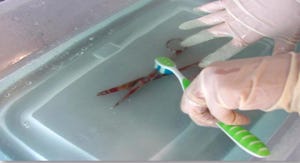
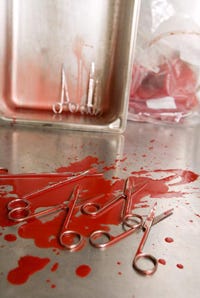
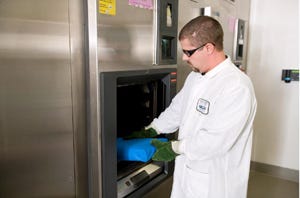
.png?width=300&auto=webp&quality=80&disable=upscale)
